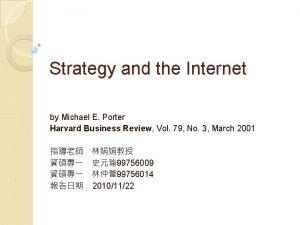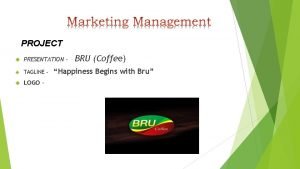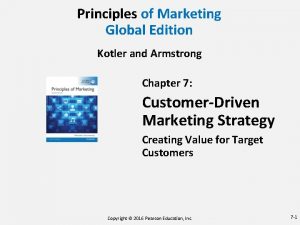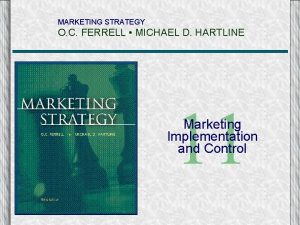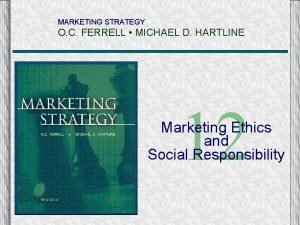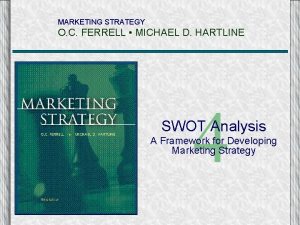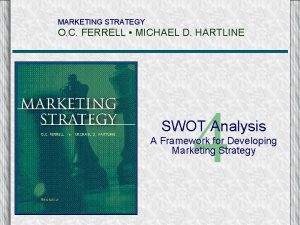MARKETING STRATEGY O C FERRELL MICHAEL D HARTLINE





















- Slides: 21

MARKETING STRATEGY O. C. FERRELL • MICHAEL D. HARTLINE 6 Market Segmentation, Target Marketing, and Positioning

Market Segmentation Strategies (1 of 2) • Traditional Approaches to Market Segmentation – Mass Marketing – Differentiated Marketing • Multisegment Approach • Market Concentration Approach – Niche Marketing 2

Mass Marketing Strategy From Exhibit 6. 1 (1 of 4) 3

Multisegment Strategy From Exhibit 6. 1 (2 of 4) 4

Market Concentration Strategy From Exhibit 6. 1 (3 of 4) 5

Niche Marketing Strategy From Exhibit 6. 1 (4 of 4) 6

Discussion Question • Can you think of a product that could be marketed effectively using a mass marketing approach? If so, explain and justify your answer. If not, what types of changes would have to be made to the product to make it appropriate for a mass marketing approach? 7

Multisegment Approach 8

Market Segmentation Strategies (2 of 2) • Emerging Approaches to Segmentation – One-to-One Marketing – Mass Customization – Permission Marketing • Criteria for Successful Segmentation – Identifiable and Measurable – Substantial – Accessible – Responsive – Viable 9

Discussion Question • Many consumers and consumer advocates are critical of the one-to-one marketing approach due to personal privacy concerns. Marketers counter that one-to-one marketing can lead to privacy abuses, but that the benefits to both consumers and marketers far outweigh the risks. Where do you stand on this issue? Why? 10

Bases for Segmenting Consumer Markets • Behavioral Segmentation – Segments based on actual behavior or product usage • Demographic Segmentation – Segments based on demographic factors (e. g. , gender, age, income, education, etc. ) • Psychographic Segmentation – Segments based on state-of-mind issues (e. g. , motives, attitudes, opinions, values, lifestyles, interests, personality, etc. ) • Geographic Segmentation – Segments based on geographic location 11

Marketing Strategy in Action • Demographic segmentation strategies, such as the one utilized in this Virginia Slims advertising campaign, are common because their ease of use and measurement. • What are the limitations of demographic segmentation? What can marketers do to compensate for these limitations? 12

VALS 13

Benefit Segmentation of the Snack Food Market Exhibit 6. 4 14

Discussion Question • What are some of the ethical and legal issues involved in targeting sensitive groups such as children and seniors? 15

Bases for Segmenting Business Markets • • • Type of Organizational Characteristics Benefits Sought or Buying Processes Personal and Psychological Relationship Intensity 16

Target Marketing Strategies • Five basic strategies for target market selection: – (1) Single Segment Targeting – (2) Selective Targeting – (3) Mass Market Targeting – (4) Product Specialization – (5) Market Specialization 17

Basic Target Marketing Strategies Exhibit 6. 6 18

Differentiation and Positioning (1 of 2) • Relative perception • Process of creating favorable relative position: – (1) Identification of target market – (2) Determination of needs, wants, preferences and benefits desired – (3) Examination of competitors’ characteristics and positioning – (4) Comparison of product offerings with competitors – (5) Identification of unique position – (6) Development of a marketing program – (7) Continual reassessment 19

Differentiation and Positioning (2 of 2) • Differentiation Strategies – Product Descriptors • Product features • Advantages • Benefits – Customer Support Services – Image • Positioning Strategies – Strengthen the Current Position – Repositioning – Reposition the Competition 20

Using Product Descriptors for Product Differentiation Exhibit 6. 7 21
 Michael hartline
Michael hartline Marketing strategy ferrell
Marketing strategy ferrell Syrgkanis
Syrgkanis Jennifer ferrell insurance agency
Jennifer ferrell insurance agency Universal functions of marketing
Universal functions of marketing Strategy and the internet
Strategy and the internet Porter strategy and the internet
Porter strategy and the internet Business strategy vs corporate strategy
Business strategy vs corporate strategy Firms that emphasize global integration make and sell
Firms that emphasize global integration make and sell What is chase strategy
What is chase strategy Multidomestic corporation
Multidomestic corporation Aligning hr strategy with business strategy
Aligning hr strategy with business strategy Transnational strategy vs global strategy
Transnational strategy vs global strategy The strategy making strategy executing process
The strategy making strategy executing process Globalization strategy
Globalization strategy Recognizing cognates in listening
Recognizing cognates in listening Directional strategies in strategic management
Directional strategies in strategic management Multinational strategy vs global strategy
Multinational strategy vs global strategy Starbucks advertising strategy
Starbucks advertising strategy Nfl target market demographics
Nfl target market demographics Bru brand logo
Bru brand logo Kotler and armstrong
Kotler and armstrong






